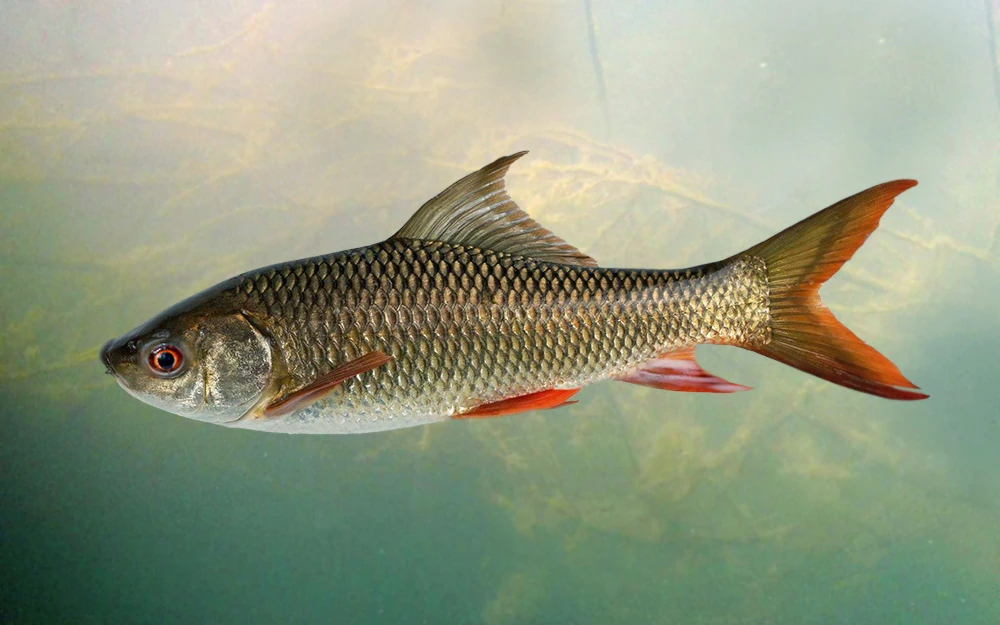Rohu fish, popularly known as Labeo rohita, is the most commonly eaten freshwater fish and holds a predominant position in South Asian countries such as India, Pakistan, Bangladesh, and Nepal. Known for its delicate taste, soft flesh and high nutritional value, Rohu is a favourite fish with anglers and cultivators alike.
If you’ve ever tasted a fiery hot Rohu curry or a crispy fried Rohu, you’ll know why it makes our list of the best fish to eat in India! But this fish has more to offer than mere taste. In this post, we will cover everything you need to know about Rohu fish, including its benefits, cooking uses, farming, and nutrition.
What Is Rohu Fish?
Rohu, a freshwater fish, is a species of carp. It is native to the rivers of the Indian subcontinent but is now extensively farmed in ponds and lakes throughout the subcontinent. The fish has a shiny, silver body with a greenish back, and it can grow quite large, weighing as much as 10 kg (22 pounds) in the wild.
The rapid growth of this fish makes it suitable for aquaculture. Farmers frequently raise it together with other species such as catla and mrigal, referred to as an “Indian major carps” composite. This not only enhances the taste of the restaurant’s special food menu but is also a great source of income for dwellers in rural areas.
Rich in Nutritional Value
Delicious and nutritious is the rohu fish. It’s packed with lean protein, which is perfect for muscle repair and maintaining overall body function. Here’s a precise look at the nutritional breakdown of 100 grams of cooked Rohu fish :
- Calories: ~97 kcal
- Protein: ~17-20 grams
- Fat: ~2-3 grams
- Omega-3 fats: Good amounts
- Vitamin A, D, and B12
- And minerals such as calcium, iron, phosphorus, and zinc
Rohu is low in saturated fat and heart-healthy when prepared with minimal oil. It is also packed with omega-3 fatty acids, which help support brain health, reduce inflammation, and keep the heart healthy.
Health Advantages
Here are a few health benefits of adding Rohu fish to your diet:
Supports Heart Health
Rohu, with its healthy fats and high omega-3 levels, can help reduce bad cholesterol and improve cardiovascular functioning.
Boosts Brain Function
The Omega-3 fatty acid content in Rohu (aquaculture studies) supports improved memory function and also regulates mood(1).Omega-3s reduce the probability of cognitive decline as well.
Strengthens Bones and Teeth
Rohu is rich in phosphorus and calcium, which are essential for maintaining bone and dental health.
Improves Skin and Hair
Vitamins in Rohu, especially vitamins A and B12, can help keep your skin clean and your hair healthy and shinier.
Growth and Development Assistant
It is also high in protein, making it beneficial for children and growing teens.
Common Ways to Cook Rohu
Rohu is a highly adaptable fish that can be cooked in a wide variety of ways. The flesh being nice and firm is very good in curries, grills, fries, and even in baked dishes. Following are some of the more popular ways to prepare Rohu:
- Fish Curry Rohu: A traditional South Asian curry made with onions, tomatoes, garlic, turmeric & spices.
- Grilled Rohu: Marinated with herbs and grilled on a grill or in a frying pan.
- Rohu Fry: Coated with flour or spices and deep fried to crispiness.
- Baked Rohu: A healthy alternative with minimal oil and a generous amount of vegetables.
- While preparing Rohu, it is worth noting that the bones can be quite challenging for kids and older adults to consume.
Rohu in Aquaculture
Rohu is very commonly found in Indian rivers due to its sweet water and extensive availability of prey for the fish. It’s normally cultivated in freshwater ponds and rivers and is often raised together with other carps in composite fish culture systems. It relies mostly on a diet of plant matter, including algae and aquatic plants, which makes it fairly inexpensive to farm.
Fish farmers are more interested in Rohu due to market demand, its better survival rate, and high flesh recovery. Rohu farming can contribute to food security and livelihoods according to an eco-friendly culture.
Conclusion
Rohu fish is considered a sustainable choice, especially when farmed sustainably. It doesn’t require high-protein feed made from other fish, unlike some other species, making its farming more environmentally friendly.
However, like all farmed fish, Rohu are as safe to eat as the water and farming practices make them. Consumers should visit reliable local markets or vendors that follow hygiene and health requirements.
FAQs
Is Rohu fish suitable for daily consumption?
Yes, Rohu fish is healthy, as it provides a good source of protein and omega-3 fatty acids. Cooked with less oil and spices, it can only be an addition to a moderate daily diet.
Do Rohu fishes has many bones?
Rohu has both small and large bones, and needs to be eaten carefully. Many develop a knack for eating it over time, or the fish can be deboned during the cooking process.
Is it safe for pregnant women to eat Rohu fish?
Yes, Rohu is safe for pregnant women to eat, provided it is cooked well. It’s relatively low in mercury and high in beneficial nutrients, such as protein, omega-3 fatty acids, and vitamin B12.
Is Rohu or Catla fish better?
Both are common across South Asia and share similar nutritional profiles. Rohu is a slightly stronger-flavored fish and has a bit more texture than catla. It boils down to what you prefer.
How do I know if Rohu fish is fresh?
The eyes of fresh Rohu will be clear, the flesh will be firm, the scales will be shiny, and there will be no strong odor. Shun fish with cloudy eyes, soft spots, or an off odor.


